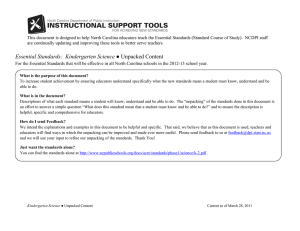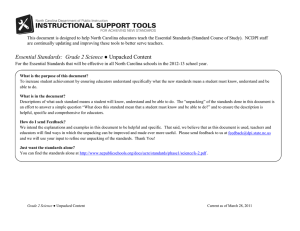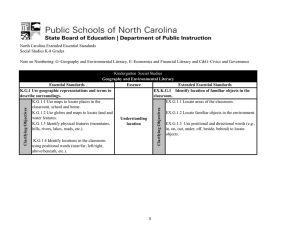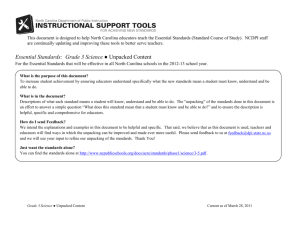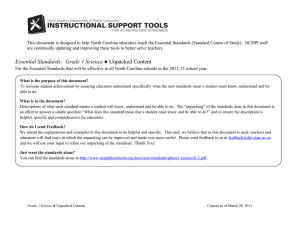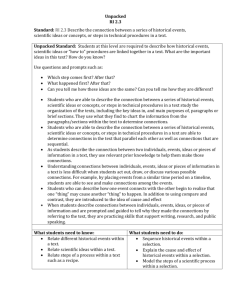Document 10710717
advertisement
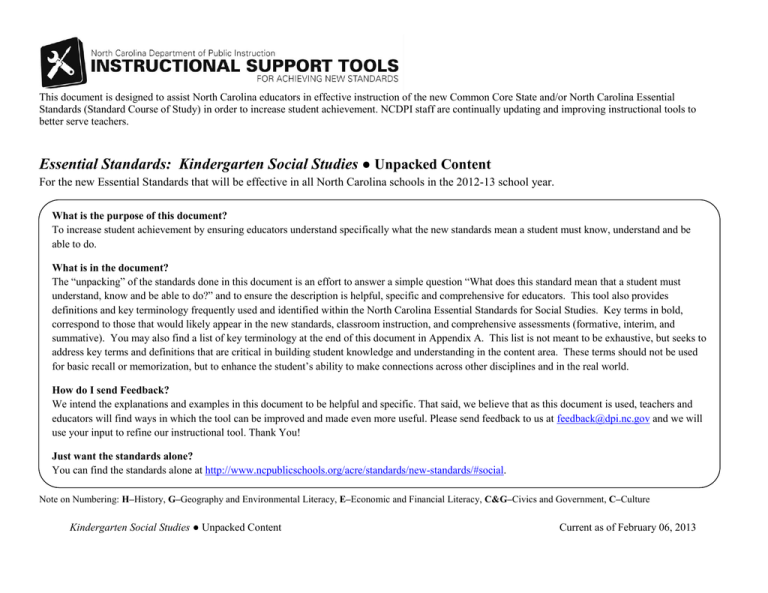
This document is designed to assist North Carolina educators in effective instruction of the new Common Core State and/or North Carolina Essential Standards (Standard Course of Study) in order to increase student achievement. NCDPI staff are continually updating and improving instructional tools to better serve teachers. Essential Standards: Kindergarten Social Studies ● Unpacked Content For the new Essential Standards that will be effective in all North Carolina schools in the 2012-13 school year. What is the purpose of this document? To increase student achievement by ensuring educators understand specifically what the new standards mean a student must know, understand and be able to do. What is in the document? The “unpacking” of the standards done in this document is an effort to answer a simple question “What does this standard mean that a student must understand, know and be able to do?” and to ensure the description is helpful, specific and comprehensive for educators. This tool also provides definitions and key terminology frequently used and identified within the North Carolina Essential Standards for Social Studies. Key terms in bold, correspond to those that would likely appear in the new standards, classroom instruction, and comprehensive assessments (formative, interim, and summative). You may also find a list of key terminology at the end of this document in Appendix A. This list is not meant to be exhaustive, but seeks to address key terms and definitions that are critical in building student knowledge and understanding in the content area. These terms should not be used for basic recall or memorization, but to enhance the student’s ability to make connections across other disciplines and in the real world. How do I send Feedback? We intend the explanations and examples in this document to be helpful and specific. That said, we believe that as this document is used, teachers and educators will find ways in which the tool can be improved and made even more useful. Please send feedback to us at feedback@dpi.nc.gov and we will use your input to refine our instructional tool. Thank You! Just want the standards alone? You can find the standards alone at http://www.ncpublicschools.org/acre/standards/new-standards/#social. Note on Numbering: H–History, G–Geography and Environmental Literacy, E–Economic and Financial Literacy, C&G–Civics and Government, C–Culture Kindergarten Social Studies ● Unpacked Content Current as of February 06, 2013 History Essential Standard: K.H.1 Understand change over time. Concept(s): Change, Region, Time Clarifying Objectives K.H.1.1 Explain how people change over time (self and others). Unpacking What does this standard mean a student will understand, know and be able to do? The student will understand: Change occurs over time and contributes to the physical and intellectual development of individuals. A person’s environment may shape personal and social growth. Learning can promote change in people. For example: learning how to get along with others The student will know: The definition of change. Types of change. The difference between past, present and future time periods. Examples of change of themselves and others. Physical growth contributes to changes in appearance (e.g., birth, crawling, walking, loss of first tooth, and first day of school). The lives of people today exhibit similarities to the lives of people who lived in the past. Ways people learn about the past. For example: photos, artifacts, diaries, stories, videos The student will be able to: Use a simple timeline. Kindergarten Social Studies ● Unpacked Content Page 2 of 12 Current as of February 06, 2013 K.H.1.2 Explain how seasons change over time. The student will understand: Seasons have unique characteristics that influence the way people live. Human behavior may be shaped by the climate of the seasons in a region. The student will know: Seasons change based on the tilt of the Earth and that particular regions exposure to the sun at that time of the year. Seasons have unique characteristics that influence the way people live. How changes of seasons, weather and the environment influence the way people live, work, dress and play. K.H.1.3 Explain the impact of how life events bring change (a new sibling, moving to a new house, a new job, a new school, etc.). The student will understand: Decisions people may make may shape the future. A change in life events may produce lasting effects. For example: having a new brother or sister, death of a loved one or pet, moving to a new house might cause you to go to a new school. The student will know: Examples of life events. How life events can change the way people live. What it means to make a decision. Kindergarten Social Studies ● Unpacked Content Page 3 of 12 Current as of February 06, 2013 Geography and Environmental Literacy Essential Standard: K.G.1 Use geographic representations and terms to describe surroundings. Concept(s): Physical Environment, Landforms, Location Clarifying Objectives Unpacking K.G.1.1 Use maps to locate places in the classroom, school and home. What does this standard mean a student will understand, know and be able to do? The student will understand: Maps and other geographic representations and tools can be used to locate specific places in the classroom, school, and home. The student will know: How to use a map (e.g., paper and digital form). A map is a representation of a real life place. There are specific features of a map that help us understand physical space (e.g., title, legend, symbols, and compass rose). How to properly use geographic terminology such as place, map, directions, etc. The student will be able to: Apply their knowledge of maps and other geographic representations and tools to locate specific places. For example, students could use a map of the classroom to locate a desk in the classroom, a map of the school to locate the library at school, a map of your home to locate your bedroom at home, etc. Draw a simple classroom, school, or home map. Demonstrate understanding of the visual description and location of the classroom, school, and home. For example: Particular features represented on the map, such as teacher’s desk, reading corner, etc. Kindergarten Social Studies ● Unpacked Content Identify the four cardinal directions (e.g., north, south, east, and west). Page 4 of 12 Current as of February 06, 2013 Key Terminology: Geographic Representation-consist primarily of maps and also include globes, graphs, diagrams, aerial and other photographs, and satellite-produced images. http://www.nationalgeographic.com/xpeditions/standards/01/index.html K.G.1.2 Use globes and maps to locate land and water features. The student will understand: Geographic representations may differ in accuracy in relation to the size of physical features and their relation to one another. The student will know: Globes and maps can be used to locate land and water features. The difference between globes and maps (e.g., paper and digital forms). A globe is a three-dimensional representation of the earth. A map is a two-dimensional representation of the earth’s surface. The student will be able to: Apply their knowledge of globes and maps to locate specific land and water features. K.G.1.3 Identify physical features (mountains, hills, rivers, lakes, roads, etc.). The student will understand: Landforms are distinguished by their physical features. The student will know: The definition of physical features. Examples of physical features of different landforms. Ways in which physical features may appear on a map or globe. The student will be able to: Identify and describe different landforms by their physical features using pictures, photos, etc. of mountains, hills, rivers, lakes, roads, etc. Identify different physical features located on a map. Kindergarten Social Studies ● Unpacked Content Page 5 of 12 Current as of February 06, 2013 K.G.1.4 Identify locations in the classroom using positional words (near/far, left/right, above/beneath, etc.). The student will know: The definition of positional words. For example: near/far, above/beneath, and left/right, etc. Positional words are used to locate specific places. The student will be able to: Recognize and model their understanding of specific locations in the classroom through the use of positional words. For example: model left from right, above from beneath, etc. Essential Standard: K.G.2 Understand the interaction between humans and the environment. Concept(s): Change, Human-Environment Interaction, Needs/Wants, Weather Clarifying Objectives K.G.2.1 Explain how people adapt to weather conditions. Unpacking What does this standard mean a student will understand, know and be able to do? The student will understand: People adapt to changing weather conditions in many different ways (physically and socially). Weather conditions in a region determine how people live, work, and play and the decisions that they make. The student will know: People live in many different environmental settings. People interact/adapt with their environment based on locations. For example: People living in colder climates wear more clothes, and people living in areas where there are floods build their houses on higher ground. Kindergarten Social Studies ● Unpacked Content Page 6 of 12 Current as of February 06, 2013 What career and leisure opportunities are available due to weather conditions. For example: Coastal communities: Beaches and warm weather in the summer provide an opportunity for tourism. Key Terminology: Adapt- to change or tailor something to fit, humans change their environment or their way of doing something to fit their current needs or goals. http://www.michigan.gov/documents/1002Glossary_48851_7.pdf K.G.2.2 Explain ways people use environmental resources to meet basic needs and wants (shelter, food, clothing, etc.). The student will understand: People use the environment to meet the basic needs and wants for shelter, food and clothing. People use tools made from environmental resources to provide shelter, food and clothing. Satisfying people’s basic needs and wants may depend on the availability of environmental resources (e.g., land, water and air). For example: Land is used to grow food, water is used to drink and provide food, etc. Environmental resources provide basic needs and wants for people. For example: Crops provide food and forests provide lumber. The student will know: Examples of environmental resources. Examples of basic needs and wants. Kindergarten Social Studies ● Unpacked Content Page 7 of 12 Current as of February 06, 2013 Economics and Financial Literacy Essential Standard: K.E.1 Understand basic economic concepts Concept(s): Needs and Wants Clarifying Objectives K.E.1.1 Explain how families have needs and wants. Unpacking What does this standard mean a student will understand, know and be able to do? The student will understand: Needs and wants may determine how people spend money and make financial decisions. Needs and wants are acquired through some form of purchase or trade. Individuals and families may earn money needed to purchase needs and wants through a variety of ways. The student will know: Examples of jobs The difference between needs and wants. Needs are something you must have for survival. Wants are something you would like to have, but it is not necessary, and you could do without it. K.E.1.2 Explain how jobs help people meet their needs and wants. The student will understand: Jobs can benefit the economy of a community through the resources that they provide. Jobs may serve as a means to meet the wants and needs of an individual, family, or group. The availability of jobs may help satisfy the need for economic stability for an individual, families, and communities. The student will know: Jobs provide money for people that allow them to make choices about purchases that serve their needs and wants. Kindergarten Social Studies ● Unpacked Content Page 8 of 12 Current as of February 06, 2013 For example: People work to receive money to purchase items such as food, clothes, cars, etc. Examples of a variety of jobs. Jobs give people money to buy things. Civics and Government Essential Standard: K.C&G.1 Understand the roles of a citizen. Concept(s): Citizenship, Rules, Rights, Responsibility, Fairness, Conflict, Cooperation Clarifying Objectives Unpacking K.C&G.1.1 Exemplify positive relationships through fair play and friendship. What does this standard mean a student will understand, know and be able to do? The student will understand: Positive relationships often depend on consideration, honesty, and fairness when playing with others. The traits of positive relationships are also qualities of a good citizen. The student will know: Specific examples of qualities of a good citizen. For example: playing fairly and making friends. Example of situations where consideration and positive relationships are exhibited (e.g., taking turns on the playground). The student will be able to: Demonstrate behaviors that exemplify fair play, consideration, honesty, and friendship. Key Terminology: Fair Play- Respect for the rules or equal treatment of all concerned. Note: This may be a good place to incorporate character education. Kindergarten Social Studies ● Unpacked Content Page 9 of 12 Current as of February 06, 2013 K.C&G.1.2 Explain why citizens obey rules in the classroom, school, home and neighborhood. The student will understand: Rules allow a community to maintain order. Obeying rules can provide safety in the classroom, school, home and neighborhood. For example: Everyone wears seat belts in the car. Obeying rules in the classroom, school, home and neighborhood helps to promote fairness and manage conflicts and disputes. For example: Games have rules to create fairness. The student will know: Why rules are needed. Examples of a responsible citizen. How to identify rules in the classroom, home, and neighborhood. They are citizens of a classroom, school, home and neighborhood. Key Terminology: Citizen- is an inhabitant of a city or town; especially: one entitled to the rights and privileges of a freeman. A U.S. citizen is anyone who is born in the United States or whose parents are U.S. citizens. http://www.civiced.org/index.php?page=wtp_ms28_sb Resources http://www.ehow.co.uk/info_7822792_kindergarten-activities-being-good-citizen.html http://constitution.laws.com/constitution-for-kids Kindergarten Social Studies ● Unpacked Content Page 10 of 12 Current as of February 06, 2013 Culture Essential Standard: K.C.1 Understand how individuals are similar and different. Concept(s): Similarities and Differences, Culture, Region Clarifying Objectives Unpacking K.C.1.1 Explain similarities in self and others. What does this standard mean a student will understand, know and be able to do? The student will understand: People have common traits, but each person has characteristics that make him/her unique. Similarities between individuals often help to create unity amongst people. The student will know: Examples of similarities between people (e.g., interests, language, physical, etc.). Terminology of words such as different, similar, and unique, same. K.C.1.2 Explain the elements of culture The student will understand: Diverse cultures may be explored through language, dress, food, art, music or other interests. (how people speak, how people dress, Cultures often share characteristics that encourage understanding and tolerance. foods they eat, etc.). Cultures often contain characteristics that are passed from generation to generation. The student will know: The elements of culture (language, dress, food, traditions, beliefs, etc). People from diverse cultures speak, dress, and eat differently due to their particular region. Ways connections can be made from one’s culture to another. Note: Remember that culture is learned behavior of people, which includes their belief systems, values, and languages, their social relationships, their institutions and organizations, and their material goods (food, clothing, buildings, art, music, etc.). Kindergarten Social Studies ● Unpacked Content Page 11 of 12 Current as of February 06, 2013 APPENDIX A: KEY TERMINOLOGY History: Life events-any major change in a person’s circumstances that affects interpersonal relationships and/or work-related, leisure or recreational activities Geography and Environmental Literacy: Geographic Representation-consist primarily of maps and also include globes, graphs, diagrams, aerial and other photographs, and satellite-produced images. Adapt- to change or tailor something to fit, humans change their environment or their way of doing something to fit their current needs or goals. Civics and Government: Fair Play- Respect for the rules or equal treatment of all concerned. Citizen- the importance of law, order, and rules with regard to any society or group of individuals Kindergarten Social Studies ● Unpacked Content Page 12 of 12 Current as of February 06, 2013

